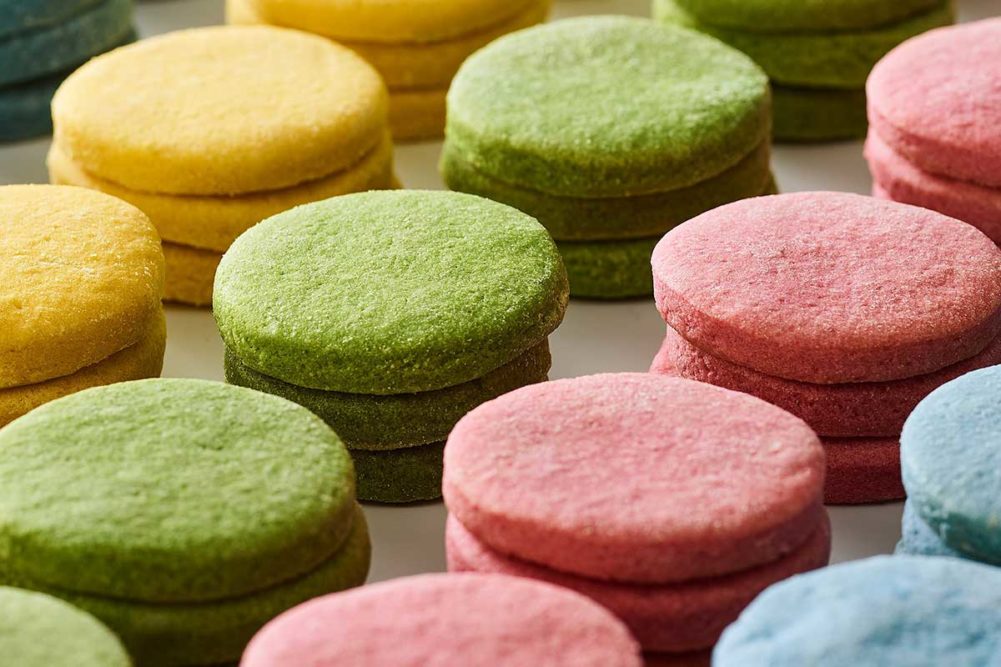Light, heat and air can all make maintaining bright colors in baked goods a challenge.
“Not all colors hold up to heat as well as we would like and especially when combined with browning, they often don’t turn out bright and vibrant,” said Emma Koziel, field application scientist I, IFPC.
Baked goods and snacks that undergo heat processing can be harsh on certain natural or synthetic colors, so heat stability is a key focus, said Meghan Skidmore, marketing specialist, Sensient Food Colors.
“With so many fresh and shelf-stable baked goods having clear windows or transparent packaging, light stability is also a concern with certain solutions like FD&C Red 3 or turmeric, so it’s important to select light-stable colors,” she added.
The materials used to make FD&C Red 3 are currently challenging from a supply chain standpoint, Ms. Skidmore said.
The pH systems of baked goods and snacks can also present obstacles, particularly when trying to achieve bright red shades.
“Anthocyanins from fruits and vegetables deliver gorgeous red hues; however, they only work in systems of pH 4 or below, making them unsuitable for bakery items,” said Kelly Newsome, senior marketing manager, colors, ADM. “On the other hand, red solutions like carmine are extremely stable, but they are not kosher.”
Susan Frecker, senior application scientist, Oterra Inc., also cited the challenge of achieving the right shade of red that can survive baking temperatures.
“Betanin pigment from beets tends to be the first choice as its shade is less effected by the pH — or alkalinity or acidity — of the product. … However, beet is one of the most heat-sensitive vegetable juice pigments,” she said. “Other pigments derived from natural sources include anthocyanin pigments that are red vegetable juice extracts from orange and black carrots, radish and sweet potato. These anthocyanins contribute red to purple shades because they are pH-sensitive and tend to become redder at lower pHs and bluer at neutral pHs typically found in baked cakes and cookies.”
Certain natural colors have been tougher to achieve than others, such as bright whites and blues.
“The industry has long been challenged to find a heat-stable blue color from natural sources,” said Ms. Newsome. “This challenge not only limits the possibility to make bold blues, but it also creates hurdles in crafting other naturally derived shades that rely on blue as a primary color, including purples, browns and greens.”
ADM developed a blue color using the Amazonian huito fruit, which stands up to heat, light and acid.
“This makes it ideal for baked goods that undergo extreme temperatures, including ultra-high heat,” Ms. Newsome said. “It’s also excellent throughout extrusion processes used for cereals and snacks, among other harsh formulation conditions.”
Spirulina extract, which is used to make blue in addition to black and green hues, is not yet approved to be used as a natural blue color for baked goods such as breads, said Alice Lee, technical marketing manager for GNT USA.
“The limitation is specifically for coloring the baked product itself,” she said. “Spirulina extract can be used to achieve blue, green and black hues in baked goods and snacks if the colors are added to fillings, sprinkles, decorative glazes or compound drizzles.”
She added that colored sugars, decorative coatings, variegates and fillings is a good way to create eye-catching appeal without coloring the entire product.
“Another bright color concept to consider is a non-homogenous swirl of color or layering color into a baked application,” Ms. Lee explained. “Baked goods such as croissants, crackers and breads containing bright streaks of color play off the contrasts, which make them appear even brighter and more intriguing to the eye.”
This article is an excerpt from the February 2023 issue of Baking & Snack. To read the entire feature on Colors & Flavors, click here.





